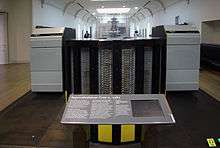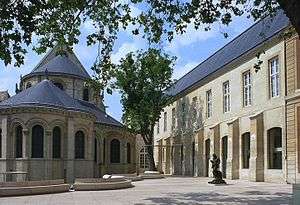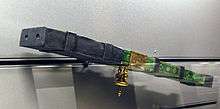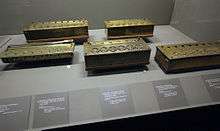Musée des Arts et Métiers
The Musée des Arts et Métiers (French pronunciation: [myze dez‿aʁz‿e metje]) (French for Museum of Arts and Crafts) is an industrial design museum in Paris that houses the collection of the Conservatoire national des arts et métiers, which was founded in 1794 as a repository for the preservation of scientific instruments and inventions.

Musée des arts et métiers | |
 | |

| |
| Established | 1794 |
|---|---|
| Location | 60,rue Réaumur, 75003 Paris |
| Collection size | 80,000 |
| Visitors | 250,000 / year |
History
Since its foundation, the museum has been housed in the deserted priory of Saint-Martin-des-Champs, in the rue Réaumur in the 3rd arrondissement of Paris. Today the museum, which underwent major renovation in 1990, includes an additional building adjacent to the abbey, with larger objects remaining in the abbey itself.
Collection
The museum has over 80,000 objects and 15,000 drawings in its collection, of which about 2,500 are on display in Paris. The rest of the collection is preserved in a storehouse in Saint-Denis. Among its collection is an original version of the Foucault pendulum, the original model of Liberty Enlightening the World (commonly known as the Statue of Liberty) by Frédéric Auguste Bartholdi, some of the first planes (Clément Ader's Avion III, Louis Blériot's Blériot XI...), and Blaise Pascal's Pascaline (the first mechanical calculator).
The museum presents seven different collections : Scientific Instruments, Materials, Energy, Mechanics, Construction, Communication, Transportation. In the former church of St-Martin-des-Champs Priory are displayed cars, planes, the Foucault Pendulum and some other monumental objects.
 Medal of the Conservatoire national des arts et métiers (Paris).
Medal of the Conservatoire national des arts et métiers (Paris). The Foucault pendulum at the Musée des Arts et Métiers
The Foucault pendulum at the Musée des Arts et Métiers Clément Ader's Avion III at the Musée des Arts et Métiers.
Clément Ader's Avion III at the Musée des Arts et Métiers. 1840-1841 Cameras obscurae for Daguerreotype called "Grand Photographe" produced by Charles Chevalier
1840-1841 Cameras obscurae for Daguerreotype called "Grand Photographe" produced by Charles Chevalier Binoculars, by Father Chérubin d'Orléans, 1681, Musée des Arts et Métiers
Binoculars, by Father Chérubin d'Orléans, 1681, Musée des Arts et Métiers
 Versions of Blaise Pascal's mechanical calculators
Versions of Blaise Pascal's mechanical calculators
Cultural references
The museum appears in literature as the scene of the climax of the 1988 novel Foucault's Pendulum by Umberto Eco, and is featured in the 2019 documentary film about the Statue of Liberty, Liberty: Mother of Exiles.
Transportation
The museum can be accessed by the Paris Métro station Arts et Métiers.
See also
- List of museums in Paris
- Nicolas-Joseph Cugnot's fardier (a pioneering steam-powered road vehicle) is an exhibit
References
External links
| Wikimedia Commons has media related to Musée des Arts et Métiers. |
- Official site (in French)
- Official site (in English)
